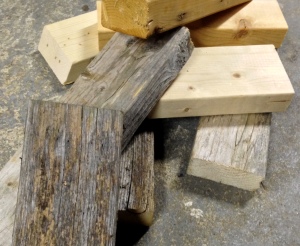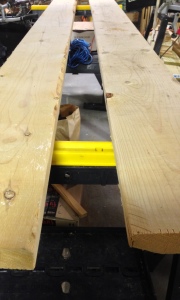If you live in Greater Boston*, you need to do this – now.
Do this now, even if you’ve never had a flood before, because we’ve never had snow like this before.
Do this now, even if you believe that the snow won’t melt for weeks to come, because until this year, we’ve never had snow like this arrive at this time before. (And who knows what will take up your time before then.)
DO NOT PROCRASTINATE

Any scraps of wood will work, and old wood you may have sitting in the shed or garage are fine.
1. Get it off the floor. Take anything that can be damaged by water and get it off the floor. Or, if you’re one to hedge your bets, at least get enough material stockpiled that you CAN lift everything off the floor if necessary. One of the simplest and least expensive options is buying a few 2x4s and cutting them to 6″ lengths. Place one block under each corner of these items.

Two or three boards across sawhorses keeps everything elevated.
Another favorite inexpensive method is to buy some plastic sawhorses and two 2″x6″x8′ or 2″x8″x8′ boards. Set up the saw horses, lay the planks on top, and pile all your items on that. Total cost will be about $40. (In the summer, this same setup makes a great buffet table for back yard events.)
NOTE: Do NOT attempt to lift dryers if you have a rigid gas line or rigid duct work. If you don’t know what I’m talking about, just leave it as is.
2. Vacuum. Seriously. If you’ve got a typical Boston-area basement filled with junk, and you’ve just moved everything off the floor, vacuum. If you get water and haven’t vacuumed then all those dust bunnies, sawdust and other items will trap moisture longer than necessary and will be difficult to clean up. (They may also clog your pump.) Your lungs will thank you too, though you might want to wear a mask while doing the vacuuming.

Even if you only have an inexpensive pump with a garden hose, it will handle smaller amounts of flooding.
3. Get a sump pump and learn how to use it. When the Great Melt occurs, you won’t be able to find one in stores. Many are inexpensive (less than $100), will use ordinary garden hoses you already own, and will function in as little as 1/8″ of water.
They can be $100 or less – small money to pay for peace of mind should flooding occur. Read the manual, now. Try setting it up (but don’t turn it on – running it without water will kill most motors). Make sure your hose(s) will reach from the farthest point of your basement to the location you want to dispose of the water. (MA Regulations require that pumps send water outside, NOT into a sink.)
4. ShopVac. These are useful items year-round, so having even a small one to suck up water at the periphery of leaks is convenient. Again, make sure you know how to use it BEFORE the flooding occurs and that you have extension cords that will allow you to reach everywhere in your basement.

Someone needs to go outside and shovel the snow away from that window to avoid melting/freezing problems.
5. Shovel around basement windows. (UPDATE: Also around the bulk head or any other item that opens outdoors.) This one is probably obvious – especially if you have windows (or bulk head or door) blocked by snow. When that water melts it will go through the cracks in the window. If it melts and freezes (and expands), that can cause problems. Get it out of there now to avoid that issue, if possible.
6. Unless you have a puddingstone foundation, shoveling around the perimeter of your home probably offers little value.

Unless you’ve got one of these, shoveling the perimeter of your home isn’t likely to do much.
UPDATE: I’m going to change my opinion and say yes, follow FEMA‘s advice, when possible. I am hard pressed to believe FEMA’s previous recommendation to shovel a 3′-5′ perimeter around home foundations. To me, shoveling a perimeter around your home isn’t likely to make much difference because water moves sideways, as well as down, through capillary action. With a bit of snow, yes, shoveling a perimeter might make a difference, but with the amount of snow we’ve had, you’d need to move it to the next block or use one of these to make any significant difference, but if you do, make sure you’re placing it downhill from your home.
Water will travel great distances in soil, sideways and even uphill through capillary action. The soil all around your home is going to be saturated. Clearing a 5′ perimeter around your home isn’t going to do much to prevent water issues.
If you do have a “puddingstone” or rock foundation, these foundations have lots of cracks (sometimes large) which can be made larger if water seeps in and freezes. Try to get snow away from these walls at the above-ground level.
7. Get all cords off the floor. If you have dehumidifiers, refrigerators, fans or anything else in the basement, get the plugs off the floor. Use inexpensive (typically blue) painter’s tape to tape the cords to the side of the unit where water won’t get into the plug.
If you do all these things, from scratch, it will probably cost you less than $200 and a few hours work. If you do get water in your basement, you’ll spend far more money and far more time, in a panic, if you haven’t prepared.
*-This information above is appropriate for people living in many areas of suburban Boston and beyond. This information is useful for people who experience minor flooding, up to a few inches. If you live on the south shore, Fall River or another area prone to severe flooding, you probably know how to deal with flooding already, and the information above isn’t appropriate for your situation.
